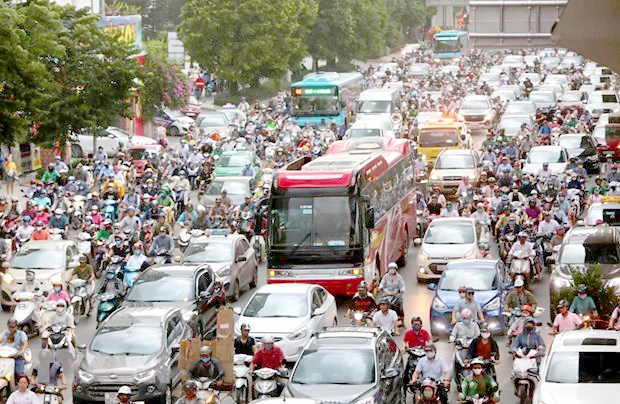Traffic congestion still a big problem for Hanoi
Despite numerous attempts by the Hanoi authorities to ease traffic congestion in the capital, roads still remain crowded.
 Traffic congestion on Nguyen Trai Street (Source: VNA)
Traffic congestion on Nguyen Trai Street (Source: VNA)Hanoi (VNS/VNA) - Despite numerous attempts by the Hanoi authorities to ease traffic congestion in the capital, roads still remain crowded.
The Department of Transport say since 2016, traffic congestion at 59 hotspots has been eased, but a further 48 problem areas have come to light.
These hotspots, the department said, are caused mainly by the rapid increase of high-rise buildings and apartments blocks in Hanoi’s downtown area, along with poor infrastructure.
Despite being expanded, the Beltway No 3, between Thanh Tri Bridge and Cau Giay district’s Mai Dich commune is still clogged as too many apartment buildings have been built along the route.
Thang Long avenue and Vo Chi Cong street are predicted to face the same problem due to mass housing projects in these areas.
Xuan Thuy street in Cau Giay district has been a traffic jam hotspot for a long time, especially the area from Lane 130 Xuan Thuy extending to the crossroads of the overpass.
At Pham Hung street area, especially at the intersection of My Dinh Bus Station, congestion also happens frequently. In addition to the personal vehicles, a large number of buses pass through the area causes difficulties to traffic flow.
Le Van Luong street used to have three lanes, but since last year, when one has become a designated bus lane, traffic jams are a common sight.
In 2019, 33 traffic hotspots were reported in Hanoi, including eight new ones on Dinh Cong bypass, Chua Lang street and Phung Chi Kien street. The city’s traffic safety committee has undertaken several solutions to ease and eliminate jams, such as installing warning signs, speed bumps and adjusting traffic lights.
But with high density of vehicles and violations of traffic rules, congestion is still an urgent matter that needs drastic measures to tackle, said Nguyen Duc Toan, deputy head of the Traffic Infrastructure Management Unit under the Hanoi Department of Transport.
The Hanoi Department of Transport is carrying out several solutions to ease jams, some of which have been successful.
These include regular review of traffic congestion hotspots and potential hotspots to adjust traffic management accordingly and developing high quality public transportation.
The other measure is to enhance the application of information technology in management, ensuring traffic safety and order, such as fining motorists who break traffic laws using traffic safety surveillance camera systems.
The department has applied the GovOne software in management and maintenance of transport infrastructure and deployed the Iparking application at public transport parking spots in the city.
In addition to installing equipment, Hanoi has expanded road lanes through cutting median strips.
The city’s bus network is developing in both quality and number. As of November 2019, Hanoi raised the number of routes to 127. The coverage of the bus route network has expanded to 30/30 districts, 457/584 communes (accounting for 78.3 percent, an increase of 4.3 percent year-on-year).
The municipal Department of Transport said it will gradually implement the scheme to curb motorcycles while improving the infrastructure and service capacity of the public transport system.
It will promote a plan of expanding public transport network in the city, build a database on road infrastructure and means of transport, install camera systems and develop an online digital map for traffic management in urban areas.
Vu Van Vien, head of the city’s Transport Department, said all solutions for the immediate and long-term period are being gradually implemented by all levels and sectors of the city in order to solve the traffic problem./.













